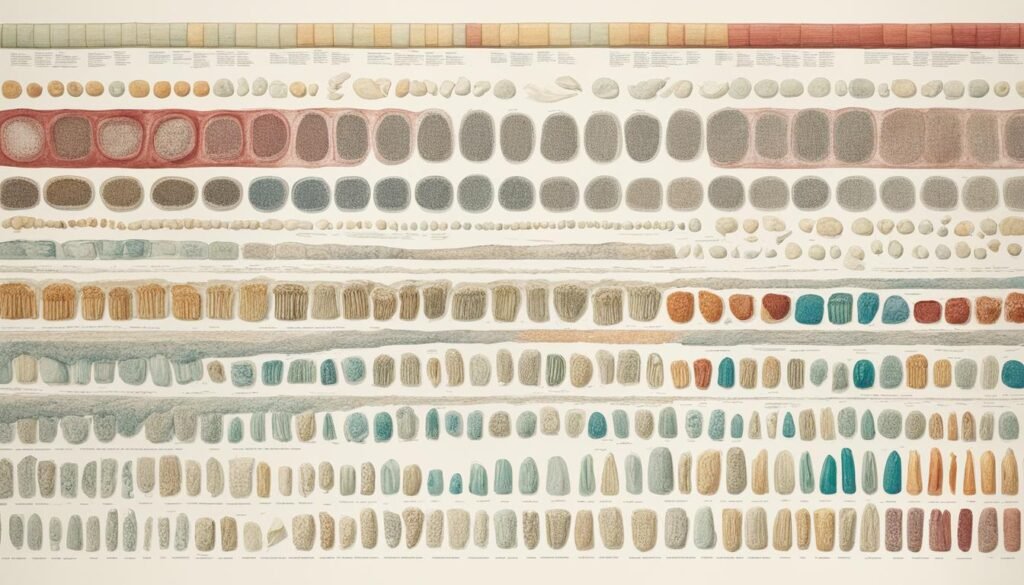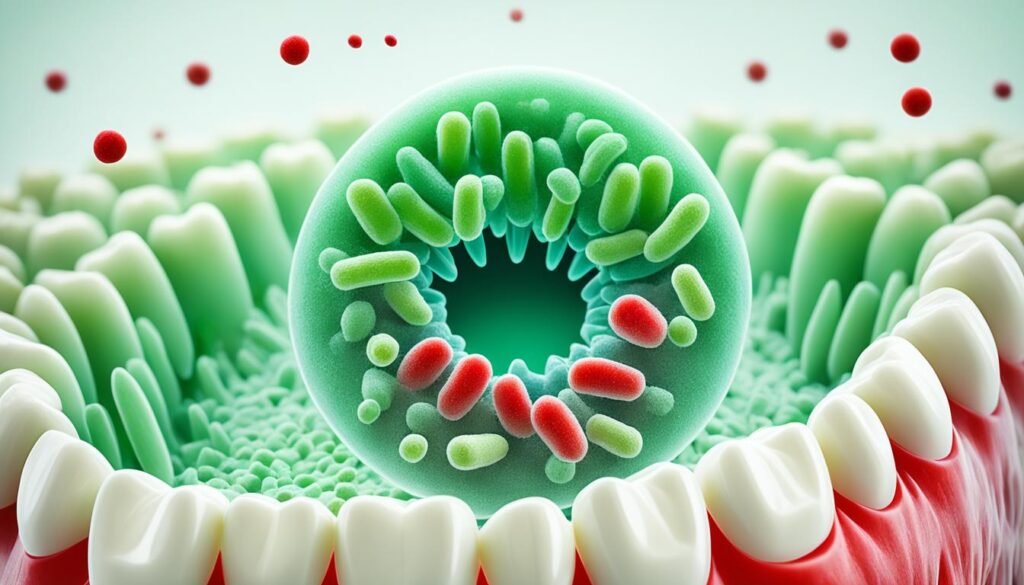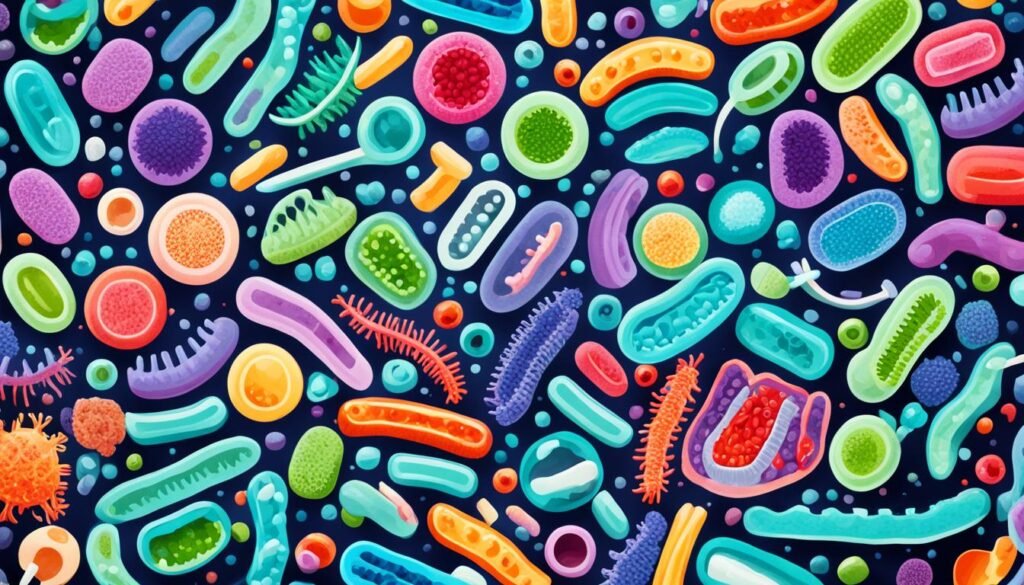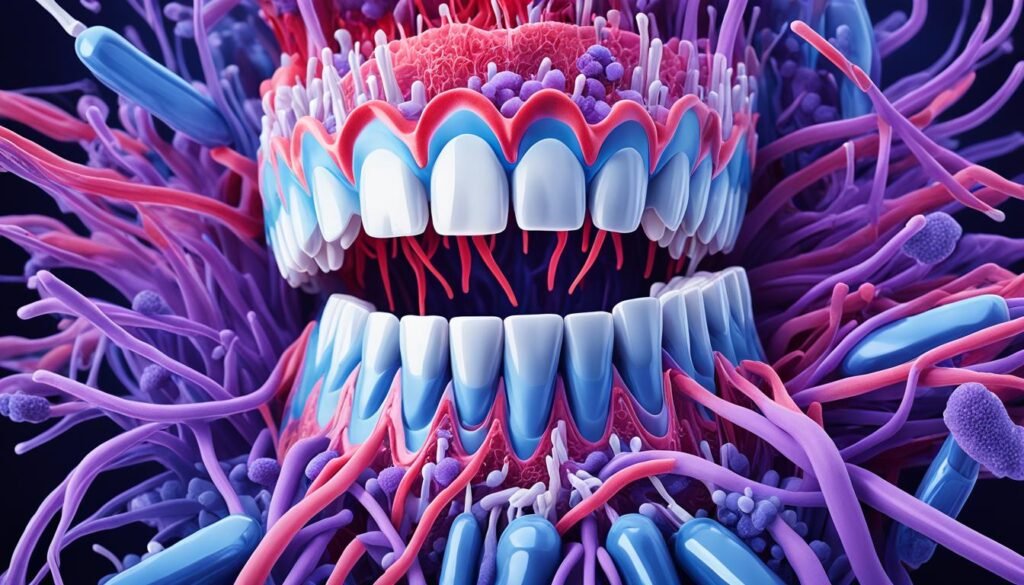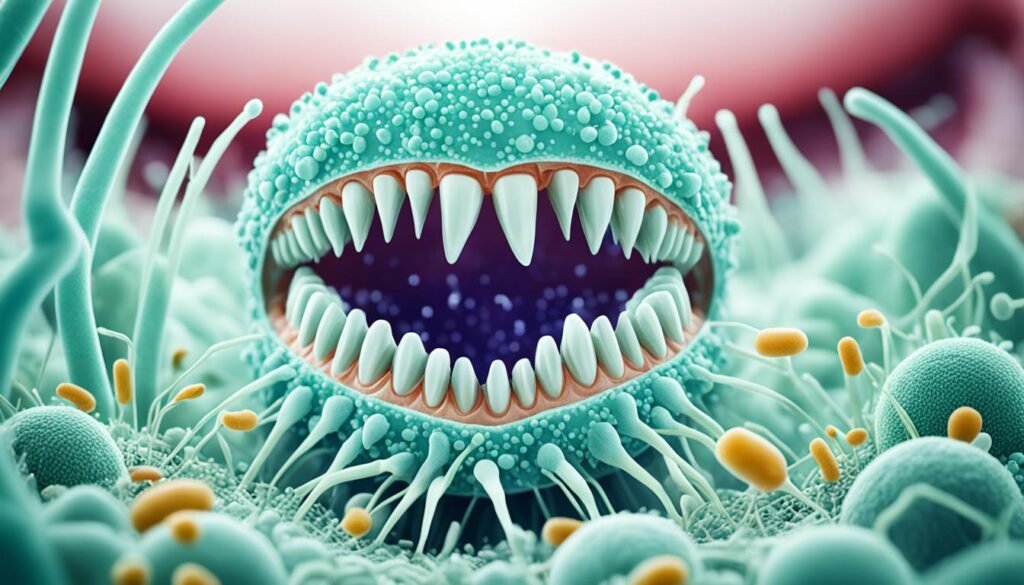When I visit my dentist, I think about the oral microbiome and its big role in dental health. In the past, I didn’t know much about the tiny life forms in my mouth and how they affect my health. Now, I see that these tiny creatures are key to a new way of taking care of our teeth.
Our mouths are home to more than 700 types of bacteria, fungi, viruses, and archaea. This mix is called the oral microbiome. It’s very important for our mouth health. If it gets out of balance, we can get cavities or gum disease.
Key Takeaways
- The oral microbiome is a complex, diverse ecosystem of over 700 microbial species in the mouth.
- Imbalances or dysbiosis in the oral microbiome can contribute to dental problems like cavities and gum disease.
- Understanding the oral microbiome’s composition and dynamics is key to developing personalized, microbiome-based dental treatments.
- Emerging technologies and diagnostic tools are enabling a deeper exploration of the oral microbiome and its impact on oral health.
- Strategies for modulating the oral microbiome, such as using probiotics and antimicrobials, hold promise for improving dental care.
What is the Oral Microbiome?
The oral microbiome is a mix of tiny living things like bacteria, archaea, fungi, viruses, and protozoa found in our mouths. It’s a complex world with over 700 different kinds of life. This makes it one of the most varied places for microbes in our bodies.
Definition and Composition of the Oral Microbiome
What lives in our mouths changes from one spot to another, like on teeth, gums, tongue, and in saliva. These places are shaped by many things, including what we eat, our age, our genes, and how we brush our teeth.
Research shows that a healthy mouth is full of trillions of tiny creatures living together. They make networks and interact with each other. This helps keep our mouths balanced and working right.
- The average mouth has over 700 types of bacteria and other tiny life forms.
- Things like our genes, diet, and how we clean our teeth affect our mouth’s tiny life.
- When the balance of these tiny lives gets off, it can lead to health problems in our mouths and bodies.
“The human oral microbiome is one of the most diverse microbial communities in the body, with over 700 different bacterial species identified to date.”
Coevolution and Historical Perspective
The story of humans and their oral microbes is one of coevolution. For millions of years, our mouths have been home to microbes that have changed and grown with us. They’ve adapted to our diet, hygiene, and environment changes.
Our oral microbiome has seen big changes over time. This is especially true when we moved from living off the land to farming and then to modern times. Things like eating more sugar, using antibiotics, and brushing our teeth more often have played a big role.
“Dental caries affects 60-90% of children and adults in industrialized countries, underscoring the profound impact of our changing lifestyles on the delicate balance of the oral microbiome.”
When humans started farming about 7,500 years ago, and with the Industrial Revolution about 200 years ago, we ate more carbs. This upset the balance in our mouths, making cavities the most common disease worldwide.
Streptococcus mutans loves the sugar in our diets and helps make biofilms that cause cavities. When our mouths can’t fix the damage from acid, cavities form.
Eating less sugar stops Streptococcus mutans from making biofilms. Fluoride also helps by making teeth stronger and stopping some bacteria from working.
Humans and our oral microbes have been evolving together for a long time. This evolution is influenced by our diet, lifestyle, and how we take care of our teeth. Knowing this history helps us fight dental diseases worldwide.
Ecological Balance and Dysbiosis
The oral microbiome is a complex mix of tiny living things that live in our mouths. They work together to keep us healthy. But when this balance is upset, we can get oral dysbiosis. This leads to too many bad microbes and can cause health problems.
Role of Microbes in Health and Disease
Microbes in our mouths help our immune system, make important substances, and stop bad germs from growing. They are key to our health. Research links oral microbiome imbalance to chronic inflammation and obesity in teens.
These microbes affect more than just our mouths. They can lead to oral cancers, heart disease, diabetes, Parkinson’s disease, and mental health issues. The link between our mouth and gut microbes is being studied closely. Keeping our microbes in balance is key to staying healthy.
Doctors are looking at ways to fix oral microbiome imbalances. They’re testing probiotics, prebiotics, and other treatments. For instance, a study found that a new therapy helped patients with dental issues and gum disease.
“The oral microbiome is a complex and dynamic ecosystem, and its delicate balance is crucial for maintaining oral and systemic health. Understanding the role of microbes in health and disease is the key to unlocking new strategies for better oral and overall well-being.”
Impact of Oral Microbiome on Dental Care
The oral microbiome is a complex mix of tiny living things in our mouths. It plays a big role in dental health. Knowing how the oral microbiome affects dental treatments helps us make better treatments. These treatments can prevent and manage oral diseases.
Recent studies have shown how the influence of oral microbiome on dental treatments works. They found that an imbalance of good and bad bacteria in our mouths can cause dental problems. By understanding this, new microbiome-based dental therapies are being developed. These aim to improve treatment results and keep our mouths healthy for a long time.
Using probiotics, prebiotics, and antimicrobials is showing promise in influencing the oral microbiome. These methods help balance the good and bad bacteria in our mouths. This can lead to better dental health.
| Microbiome-Based Dental Therapies | Potential Benefits |
|---|---|
| Probiotic Supplements | Help good oral bacteria grow and stop bad ones from growing. This can lower the risk of cavities and gum disease. |
| Prebiotic Treatments | Give nutrients to good oral microbes, helping them thrive. This makes the oral microbiome healthier. |
| Antimicrobial Interventions | Target bad bacteria in the mouth without harming the overall balance of the oral microbiome. |
By using the influence of oral microbiome on dental treatments, doctors can make dental care better and more tailored to each patient. This approach could lead to better health outcomes and less dental disease.
Dental Caries and the Oral Microbiome
Dental caries, a common oral health issue, is closely tied to the balance of the oral microbiome. Bacteria like Streptococcus mutans thrive in acidic conditions and harm tooth enamel, leading to cavities.
Research links changes in the oral microbiome to dental caries. An increase in harmful bacteria and a drop in protective ones are key factors. In 2019, about 43% of children worldwide had untreated cavities in baby teeth. This means 514 million kids suffered from it.
Role of Acidogenic and Aciduric Bacteria
The oral microbiome is full of life and balance is key. Acidogenic and aciduric bacteria are bad for teeth, making them weak and prone to cavities. They live off acidic foods and spit out more acid, eating away at tooth enamel.
But, some microbes might actually help protect teeth. For example, microbes in black stains on teeth could make saliva stronger and teeth less likely to decay.
| Statistic | Percentage/Number |
|---|---|
| Estimated average prevalence of dental caries in deciduous teeth worldwide in 2019 | 43% (38% in high-income countries and 46% in low-income counties) |
| Children globally suffering from untreated caries in deciduous teeth | 514 million |
| Estimated age-standardized prevalence of dental caries in permanent teeth | 29.4% |
| Adults having untreated caries in permanent teeth | 2.3 billion |
The link between the oral microbiome and dental caries shows how vital it is to keep our mouths balanced. By understanding how certain bacteria harm and others help, we can fight cavities better.
Periodontal Disease and the Oral Microbiome
The link between the oral microbiome and periodontal diseases like gingivitis and periodontitis is very interesting. These diseases are tied to changes in the balance of oral bacteria. This balance is known as the oral microbiome.
Periodontal diseases happen when the balance of oral bacteria shifts. This shift leads to more anaerobic, Gram-negative bacteria. These bacteria are key in making these diseases worse. Knowing which bacteria are present can help in treating these diseases.
Almost half the world has periodontitis, showing how common it is. A 2018 study found that the oral microbiome affects gingivitis. This shows why keeping the oral bacteria in balance is crucial.
Saliva helps keep the mouth healthy by managing the oral bacteria. A 2021 study showed how important saliva is. Changes in saliva can lead to periodontal diseases. This means we need to take care of our whole mouth for good health.
- The oral microbiome has over 700 bacterial species, with Streptococcus being the most common.
- The “red complex” bacteria are linked to periodontal diseases. They include Porphyromonas gingivalis, Treponema denticola, and Tannerella forsythia.
- Probiotics can help improve oral health. They are good for managing periodontal diseases, cavities, Candida infections, and bad breath.
Learning more about the oral microbiome is key to better dental care. This knowledge can lead to better oral health and less periodontal disease.
Oral Microbiome Modulation Strategies
Keeping the oral microbiome in balance is key for good dental health. Many strategies aim to support a healthy mix of microbes. This helps fight the bad effects of an imbalance in the mouth.
Probiotics, Prebiotics, and Antimicrobials
Probiotics are live good bacteria that help our health. They can make or fix a healthy balance of microbes in the mouth. Probiotics are used in dental care to fight dental caries and periodontal disease.
Prebiotics feed the good microbes, helping keep the mouth balanced. Research is looking into how prebiotics can help manage the oral microbiome.
Antimicrobial agents can target and stop bad bacteria. This helps keep the good microbes safe and lowers disease risk.
| Strategies for Oral Microbiome Modulation | Key Benefits |
|---|---|
| Probiotics | Displace disease-causing pathogens, encourage growth of beneficial species |
| Prebiotics | Provide food source for desirable bacteria, maintain balanced oral ecosystem |
| Antimicrobials | Selectively target and disrupt harmful bacteria, preserve beneficial members |
Using probiotics, prebiotics, and antimicrobials can help keep the oral microbiome healthy. This supports better oral and overall health.
Emerging Technologies and Diagnostic Tools
The study of the oral microbiome has seen big changes thanks to new molecular and sequencing tech. 16S rRNA gene sequencing and metagenomics have changed how we see the microbes in our mouths. These new methods help us understand the mix of microbes and their roles in health and sickness.
New tools based on these tech advances are very promising for checking and treating oral health. Dentists can now look at your mouth’s unique microbes to make treatments just for you. This is key for fighting dental problems and even health issues linked to bad oral microbes.
| Technology | Application in Oral Microbiome Analysis |
|---|---|
| 16S rRNA Gene Sequencing | Identifies and studies the bacteria in our mouth’s microbiome |
| Metagenomics | Looks at all the microbes, including bacteria, viruses, and fungi, in our mouths |
| Artificial Intelligence and Machine Learning | Helps automatically understand and use complex data from our mouth’s microbes for diagnosis and treatment |
As we learn more about the oral microbiome, using these new tech in dental care will be more important. By focusing on each person’s unique mouth microbes, dentists can better keep our mouths healthy. This helps our overall health too.
“The oral cavity harbors more microbes than any other part of the body except the gastrointestinal tract.”
Implications for Oral Health and General Well-being
The oral microbiome is more than just a local issue. It deeply affects our overall health and well-being. Studies show a strong link between mouth microbes and various health issues. These include heart diseases, diabetes, and some cancers.
Keeping the oral microbiome healthy is key. When it’s out of balance, it can lead to serious health problems. Bacteria from the mouth can spread through the bloodstream, affecting other parts of the body.
- Periodontal diseases like gingivitis and periodontitis are linked to heart problems. These include atherosclerosis, high blood pressure, and stroke.
- People with diabetes often have worse gum disease. Poor gum health can make diabetes harder to manage.
- Respiratory infections, like pneumonia, can come from swallowing oral bacteria. This shows how oral and respiratory health are connected.
- Pregnant women with gum disease face a higher risk of premature birth and low birth weight. This highlights the need for good oral health during pregnancy.
The effects of the oral microbiome on our health are wide-ranging. Understanding these links is key to a holistic healthcare approach. By keeping the mouth healthy through good hygiene, diet, and managing health conditions, we can protect our overall well-being.
“The mouth is the gateway to the body, and the health of the oral microbiome is intricately linked to our general health and well-being.”
As research grows, we see the promise of new solutions based on the oral microbiome. This could help tackle many health issues. By learning from the oral microbiome, we can improve healthcare. This approach values the big role our oral health plays in our overall health and life quality.
Challenges and Future Directions
Significant progress has been made in understanding the oral microbiome. Yet, there are still challenges and gaps in knowledge that need more study. One big issue is the need for standard ways to collect and analyze samples. This would make it easier to compare results from different studies.
Another challenge is understanding the role of non-bacterial microbes like fungi and viruses. These have not been studied much but are thought to be important for oral health.
Figuring out how the human body and its microbes interact is also hard. The balance between us and our microbes is key to our health. We need more research to understand these complex relationships.
| Challenges in Oral Microbiome Research | Future Research Directions |
|---|---|
|
|
The future looks bright for studying the oral microbiome. New technologies like next-generation sequencing and metabolomics will help us learn more about it. These advances could lead to new ways to improve oral and overall health. This could mean more personalized treatments.
“Harnessing the power of the oral microbiome holds immense potential for revolutionizing dental care and optimizing human health.”
Conclusion
The oral microbiome is a complex world that deeply affects our dental health and overall well-being. It shows how humans and microbes have evolved together. This balance is key to a healthy mouth.
Research has shown the oral microbiome’s role in fighting dental problems like cavities and gum disease. It also links to gut health and even brain function. This opens new ways to care for our teeth and overall health.
Future advancements in diagnosing and changing the oral microbiome excite me. These tools could change how we care for our teeth. I look forward to seeing how this field will shape the future of dentistry.
FAQ
What is the oral microbiome?
The oral microbiome is a complex mix of microorganisms found in our mouths. It includes bacteria, archaea, fungi, viruses, and protozoa. This mix is very diverse, with over 700 different species. It’s one of the most diverse places in our bodies.
How has the oral microbiome evolved with humans?
Humans and their mouth microbes have evolved together for millions of years. The types of microbes in our mouths have changed with our diet, hygiene, and environment. Big changes have happened, especially when we moved from living in the wild to farming and then to city life.
What is the impact of oral microbiome dysbiosis?
When the balance of microbes in our mouths gets disrupted, it’s called dysbiosis. This can lead to too many bad microbes and health problems. These microbes help keep our immune system strong, make important substances, and stop bad germs from growing. So, they’re key to our health.
How does the oral microbiome influence dental care?
The oral microbiome affects dental health in many ways. It helps prevent cavities and treat gum diseases. Knowing how the microbiome and dental health interact helps us find better treatments.
What is the role of the oral microbiome in dental caries?
Dental cavities are caused by the mix of microbes in our mouths. Some microbes, like Streptococcus mutans, make acid that can harm tooth enamel and cause cavities.
How does the oral microbiome impact periodontal diseases?
Periodontal diseases, like gingivitis and periodontitis, are linked to changes in the oral microbiome. When the balance of microbes shifts, it can lead to these diseases.
What are the strategies for modulating the oral microbiome?
To keep the oral microbiome healthy, we use probiotics, prebiotics, and special treatments. These help balance the microbes in our mouths and support good oral health.
How are emerging technologies advancing our understanding of the oral microbiome?
New technologies like 16S rRNA gene sequencing are changing how we study the oral microbiome. They let us see the variety of microbes in our mouths and find links to health and disease.
What are the broader implications of the oral microbiome on overall health?
The oral microbiome is important for our overall health, not just our mouths. Changes in our mouth microbes can affect our heart, diabetes, and even some cancers.
What are the current challenges and future directions in oral microbiome research?
We’ve made big strides in understanding the oral microbiome, but there’s still much to learn. We need better ways to study it and understand how microbes and our bodies interact. New research and technology will help us find better ways to improve our health.
Source Links
- https://www.ncbi.nlm.nih.gov/pmc/articles/PMC9601200/ – Oral Microbiome and Dental Caries Development
- https://www.ncbi.nlm.nih.gov/pmc/articles/PMC9405223/ – Oral Microbiota, Its Equilibrium and Implications in the Pathophysiology of Human Diseases: A Systematic Review
- https://askthedentist.com/oral-microbiome/ – The Oral Microbiome & Its Impact on Every Other System in the Body
- https://www.ncbi.nlm.nih.gov/pmc/articles/PMC6503789/ – Oral microbiome: Unveiling the fundamentals
- https://www.rejuv-health.com/biological-dentistry/oral-microbiome/ – Oral Microbiome: What it is & how it impacts your health | Rejuvenation Health
- https://www.ncbi.nlm.nih.gov/pmc/articles/PMC8457218/ – The oral microbiome: Role of key organisms and complex networks in oral health and disease
- https://www.ncbi.nlm.nih.gov/pmc/articles/PMC6338091/ – Exploiting the Oral Microbiome to Prevent Tooth Decay: Has Evolution Already Provided the Best Tools?
- https://www.ncbi.nlm.nih.gov/pmc/articles/PMC10829892/ – Oral microbiota, co-evolution, and implications for health and disease: The case of indigenous peoples
- https://www.ncbi.nlm.nih.gov/pmc/articles/PMC10304820/ – Oral Microbiome in Health and Disease: Maintaining a Healthy, Balanced Ecosystem and Reversing Dysbiosis
- https://www.rupahealth.com/post/imbalances-and-consequences-of-dysbiosis-in-the-oral-microbiome – No title found
- https://southdakota.deltadental.com/blog/connection-between-oral-health-and-gut-health/ – The connection between oral health and gut health
- https://www.mdpi.com/1422-0067/23/9/5142 – Impact of Oral Microbiome in Periodontal Health and Periodontitis: A Critical Review on Prevention and Treatment
- https://dentistry.uiowa.edu/news/2022/02/developing-comprehensive-understanding-oral-microbiome-and-its-impact-overall-health – Developing a Comprehensive Understanding the Oral Microbiome and Its Impact on Overall Health
- https://www.mdpi.com/2076-2607/12/1/121 – The Evolving Microbiome of Dental Caries
- https://www.frontiersin.org/journals/microbiology/articles/10.3389/fmicb.2023.1081629/full – Frontiers | Characterization of the oral microbiome and gut microbiome of dental caries and extrinsic black stain in preschool children
- https://bmcoralhealth.biomedcentral.com/articles/10.1186/s12903-020-01262-9 – The oral microbiome and salivary proteins influence caries in children aged 6 to 8 years – BMC Oral Health
- https://www.mdpi.com/1422-0067/24/6/5231 – The Role of the Oral Microbiome in the Development of Diseases
- https://www.ncbi.nlm.nih.gov/pmc/articles/PMC9103139/ – Impact of Oral Microbiome in Periodontal Health and Periodontitis: A Critical Review on Prevention and Treatment
- https://www.ncbi.nlm.nih.gov/pmc/articles/PMC10445586/ – The increasing importance of the oral microbiome in periodontal health and disease
- https://www.ncbi.nlm.nih.gov/pmc/articles/PMC6732124/ – Review: modulation of the oral microbiome by the host to promote ecological balance
- https://www.nature.com/articles/sj.bdj.2016.865 – The oral microbiome – an update for oral healthcare professionals – British Dental Journal
- https://www.frontiersin.org/journals/microbiology/articles/10.3389/fmicb.2018.03323/full – Frontiers | Exploiting the Oral Microbiome to Prevent Tooth Decay: Has Evolution Already Provided the Best Tools?
- https://www.pershingfamilydental.com/the-impact-of-microbiome-research-on-oral-health-what-you-need-to-know/ – The Impact of Microbiome Research on Oral Health: What You Need to Know – PERSHING FAMILY DENTAL | Dentist in Central El Paso, TX
- https://www.ncbi.nlm.nih.gov/books/NBK578292/ – Emerging Science and Promising Technologies to Transform Oral Health – Oral Health in America
- https://yourvalleydental.com/blog/oral-microbiome-the-impact-on-dental-and-general-health/ – Oral Microbiome: The Impact on Dental and General Health – Valley Dental Care
- https://www.rupahealth.com/post/the-role-of-the-oral-microbiome-in-maintaining-healthy-teeth-and-gums – No title found
- https://www.mayoclinic.org/healthy-lifestyle/adult-health/in-depth/dental/art-20047475 – Oral health: A window to your overall health
- https://dentistsofhinsdalelake.com/oral-microbiome-balance-the-ultimate-guide/ – Oral Microbiome Balance: The Ultimate Guide
- https://www.frontiersin.org/journals/oral-health/articles/10.3389/froh.2020.00002/full – Frontiers | Grand Challenges in Oral Infections and Microbes
- https://www.dentalcare.ca/en-ca/thought-leader-articles/understanding-the-critical-role-of-the-human-microbiome-in-oral-systematic-health – UNDERSTANDING THE CRITICAL ROLE OF THE HUMAN MICROBIOME IN ORAL SYSTEMATIC HEALTH





